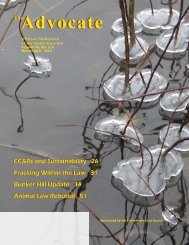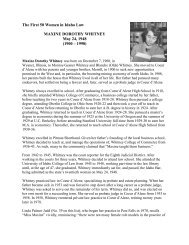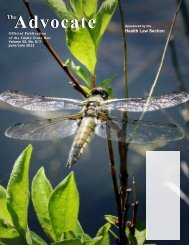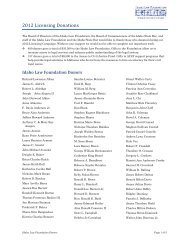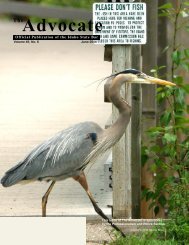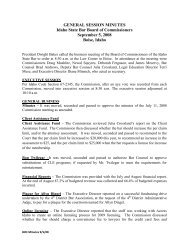The Advocate - May 2012 - Idaho State Bar - Idaho.gov
The Advocate - May 2012 - Idaho State Bar - Idaho.gov
The Advocate - May 2012 - Idaho State Bar - Idaho.gov
You also want an ePaper? Increase the reach of your titles
YUMPU automatically turns print PDFs into web optimized ePapers that Google loves.
“She could have been making a religious<br />
statement” has both a subject and a verb<br />
and is an independent clause.<br />
Also, make sure the phrases and clause<br />
you’re joining are in parallel structure.<br />
Parallelism is the use of similar grammatical<br />
form for coordinated elements.<br />
In non-grammarian terms, this means you<br />
match nouns with other nouns, verbs with<br />
other verbs, prepositional phrases with<br />
propositional phrase, and so on . . . .<br />
Wrong: Under the Open Meetings<br />
Law, the public is not only entitled to attend<br />
<strong>gov</strong>ernmental meetings, but also to<br />
be given notice of the time, place, and<br />
subject matter of those meetings.<br />
Correct: Under the Open Meetings<br />
Law, the public is entitled not only to attend<br />
<strong>gov</strong>ernmental meetings, but also to<br />
be given notice of the time, place, and<br />
subject matter of those meetings.<br />
<strong>The</strong> first example is incorrect because<br />
the verbs are not in the same tense; in the<br />
second example the verbs are.<br />
<strong>The</strong> use of parallelism is especially<br />
important when presenting long or complicated<br />
ideas to the reader.<br />
Wrong: <strong>The</strong> author claim that it was<br />
not only wrong to tell just one side of the<br />
story, but also people had the right to<br />
hear the other side of the story and that<br />
he could write what he wanted.<br />
Correct: <strong>The</strong> author claimed not only<br />
that it was wrong to tell just one side of the<br />
story, but also that people had the right to<br />
hear the other side of the story and that he<br />
had the right to write what he wanted.<br />
<strong>The</strong> first example is more difficult<br />
to understand because the writer’s three<br />
ideas are in a mish-mash of grammatical<br />
forms. In the second example the<br />
writer has helped the reader follow her<br />
three ideas by using “that” to begin each<br />
idea and by using grammatically parallel<br />
clauses.<br />
Subordinating conjunctions<br />
Subordinating conjunctions are used<br />
when the elements of a sentence are not<br />
equal. <strong>The</strong>se conjunctions introduce subordinate<br />
clauses and explain the clause’s<br />
relationship to the rest of the sentence.<br />
Common subordinating conjunctions include<br />
after, although, as, as if, as long<br />
as, because, before, even though, if, in<br />
order that, now that, rather than, since,<br />
so that, than, that, though, unless, until,<br />
when, whenever, where, whereas, whether,<br />
while.<br />
Subordinate clauses are patterned like<br />
sentences; they have subjects and verbs.<br />
But, because these clauses include a sub-<br />
52 <strong>The</strong> <strong>Advocate</strong> • <strong>May</strong> <strong>2012</strong><br />
<strong>The</strong> use of parallelism is especially<br />
important when presenting long<br />
or complicated ideas to the reader.<br />
ordinating conjunction, they cannot stand<br />
alone as sentences:<br />
Although he yelled fire in the crowded<br />
theater.<br />
Instead, we use subordinating conjunctions<br />
to create clauses that help the<br />
reader better understand the main clause<br />
of the sentence by explaining the when,<br />
where, or why.<br />
Although he yelled fire in the crowded<br />
theater, the patrons exited in an orderly<br />
fashion.<br />
Use subordinating conjunctions to let<br />
the reader know the sentence elements are<br />
not equal and to help you emphasize the<br />
more important idea. (Determining which<br />
is the more important idea is up to you.)<br />
<strong>The</strong> speech was vulgar, lewd, obscene,<br />
and plainly offensive, but the court ruled<br />
it was protected.<br />
Even though the speech was vulgar,<br />
lewd, obscene, and plainly offensive, the<br />
court ruled it was protected.<br />
Conclusion<br />
Using coordinating conjunctions,<br />
correlative conjunctions, and subordinating<br />
conjunctions can help your readers<br />
better understand your writing and your<br />
thoughts. <strong>The</strong>y can also add nuance and<br />
balance to our writing.<br />
And, just in case the tune for Conjunction<br />
Junction has left your mind after<br />
this grammar lesson, I leave you with this<br />
verse:<br />
In the mornings, when I’m usually<br />
wide awake, I love to take a<br />
walk through the gardens and down<br />
by the lake, where I often see a duck<br />
and a drake, and I wonder, as I walk<br />
by, just what they’d say if they could<br />
speak, although I know that’s an absurd<br />
thought.<br />
About the Author<br />
Tenielle Fordyce-Ruff is a partner at<br />
Rainey Law Office. Her practice focuses<br />
on civil appeals. She was a visiting professor<br />
at University of Oregon School of<br />
Law teaching Legal Research and Writing,<br />
Advanced Legal Research, and Intensive<br />
Legal Writing and, prior to that,<br />
clerked for Justice Roger Burdick of the<br />
<strong>Idaho</strong> Supreme Court. While clerking<br />
for Justice Burdick, she authored <strong>Idaho</strong><br />
Legal Research, a book designed to help<br />
law students, new attorneys, and paralegals<br />
navigate the intricacies of researching<br />
<strong>Idaho</strong> law. You can reach her at tfr@<br />
raineylawoffice.com.<br />
Sources<br />
• <strong>The</strong> lyrics for Conjunction Junction<br />
can be found at http://www.schoolhouserock.tv/Conjunction.html.<br />
You<br />
can also view the original Conjunction<br />
Junction at http://www.youtube.<br />
com/watch?v=ODGA7ssL-6g.<br />
• Anne Enquist & Laurel Currie Oates,<br />
Just Writing: Grammar, Punctuation,<br />
and Style for the Legal Writer at<br />
202-204 (3d ed. 2009).<br />
• Bryan A. Garner, <strong>The</strong> Redbook: A<br />
Manual on Legal Style at 178-181<br />
(2d ed. 2006).<br />
Endnotes<br />
1 For a refresher on how to correctly punctuate independent<br />
clauses joined with these seven coordinating<br />
conjunctions, see “Six Simple Steps to Correct<br />
Commas,” <strong>The</strong> <strong>Advocate</strong> 49-50 (September 2011),<br />
available at https://isb.idaho.<strong>gov</strong>/pdf/advocate/issues/adv11sep.pdf.



